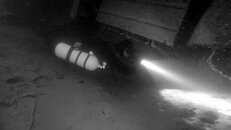I have a couple questions about how to go about getting into SM in order to pursue tech diving. 1) I have two X7 HP100s. If I wanted to use them, would I need to change the valve on one of them so they both face up while sidemounted?
No, you do not NEED to change the valves. If you have the money, and want to get a valve to replace one of them, by all means do so. As DA pointed out, it might make it a bit easier. But, if you travel and want to dive SM, the chances are you will end up with two cylinders with standard valves, so you may as well get used to diving that configuration.
2) Is there a downside to learning tech on SM without doing BM doubles? I've read posts regarding diving SM versus BM, but what about being instructed in SM, especially by someone who doesn't dive SM? (I don't know of any SM instructors here)
Your're really asking two different questions here. a) Can you move into tech without a BM background (i.e. start SM and continue SM); and b) can you learn SM from a BM diver who doesn't dive SM?
The first question is tricky to answer. Many (I suspect most / almost all) doubles divers started BM before moving into SM, and it is hard to answer the question, 'What if I didn't have the BM background?' I am one of those. But, I suspect that the answer is 'Yes'. Many of the principles of tech diving are related to time, depth, gas, and equipment considerations independent of whether the double cylinders are manifolded or not. I was hoping that someone, who started SM and dives SM exclusively, would respond, because I would like to hear their particular experience. But, I am having troiuble thinking of a reason why a SM-only background would not work.
The second question will necessarily prompt a biased answer. Yes, you can learn many of the principles of diving dual SM cylinders from someone who has good BM experience only. But, you can learn even more - about the SM configuration - from people who have been actively diving a SM configuration, whether they are an instructor or not. SM is still an exciting DIY-ish world, and many SM divers continue to tweak their rigs to see if there is a better configuration. And, you will probably learn more from someone who has been, and still is, doing that - based on their actual experiences.
The following comments are not intended as blasphemy in regard to proper training. I started diving BM before I ever took any technical training. Yes, I used advice from a diver / instructor on assembling manifolded doubles and configuring my regs. But, I bascially read a lot, doubled up some HP120s, and took them out to the quarry, and then off the NC coast, to get a feel for them. I wasn't attemtping deep, decompression dives without training, rather I was getting used to weighting, and buoyancy and trim. I think that experienmce helped me later, when I took tech.
Likewise, I started diving SM, albeit after a lot of BM diving, before I ever took any SM training. Taking formal training later was great, because I had already encountered a lot of issues on which I wanted to get input.
You have had several offers of mentorship, and hopefully will be able to take advantage of them. If you become comfortable diving sidemounted cylinders, there is no reason that you should not use that configuration successfully in tech training.




